Ravensburger In the Year of the Dragon User Manual
Displayed below is the user manual for In the Year of the Dragon by Ravensburger which is a product in the Board & Card Games category. This manual has pages.
Related Manuals
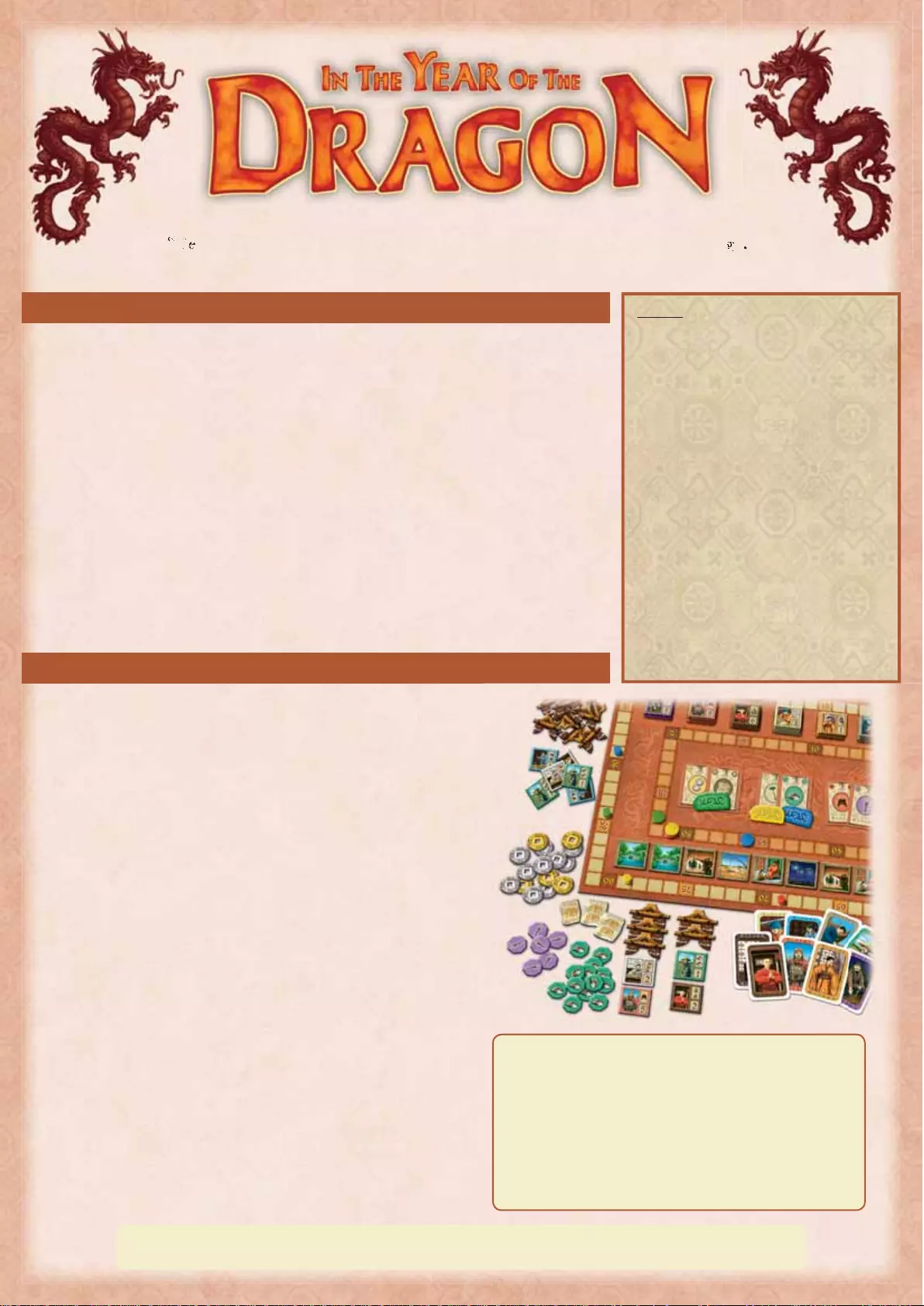
THE GOAL
In this game, players takePO the role of Chinese nobles, seeking to maximize
the prosperity and prestige of their provinces in ancient China in 1,000 A.D.
To assist them, the nobles must call upon the diverse talents of their courtiers,
from scholars and monks to warriors and craftsmen. ese loyal subjects lend
their expertise to shield their rulers from the often disastrous consequences of
the misfortunes that plague the populace from month to month.
Be it drought, contagion, or Mongol invasion, only foresight and planning
will spare the nobles and their subjects from an unlucky demise.
e better the players are at withstanding the unending onslaught of hazard-
ous events, the more honor and victory points they will have to show for it in
the end.
CONTENTS
1 Game Board
60 Cards (per player: 11 person cards and
1 replacement card)
90 Person Tiles (10 each: Craftsmen, Court Ladies,
Pyrotechnists, Tax Collectors, Warriors, Monks,
Healers, Farmers, Scholars)
66 Palace Floors
36 Yuan Coins (21 silver of value 1, and 15 gold of value 3)
26 Rice Tiles
14 Fireworks Tiles
12 Event Tiles (2 each: Peace, Drought, Contagion,
Mongol Invasion, Imperial Tribute, Dragon Festival)
8 Privilege Tiles (5 small, 3 large)
7 Action Cards
5 Dragons (1 per player)
5 Stands (1 per dragon)
5 Scoring Markers (8-sided markers, 1 per player)
5 Person Markers (round markers, 1 per player)
GOAL
Players take on the role of ancient
Chinese nobles
Loyal courtiers help navigate the
troublesome events that befall their
provinces
e player who best survives these
dicult times will collect the most
victory points and win the game
If you are reading these rules for the first time, disregard the bold text in the boxes on the right-hand side of each
page. This text is meant to serve as a quick SFNJOEFSto help you remember these rules in later games.
“He who has no vision for the small things also blinds himself to the greater design.”
(Confucius, 551-479 B.C.)
For “e Great Wall of China” expansion:
1 action card ("building the wall")
30 wall tiles (6 per player)
For “e Super Events” expansion:
10 small "corners"
gngn
.”.”
“H“H
“H
e e
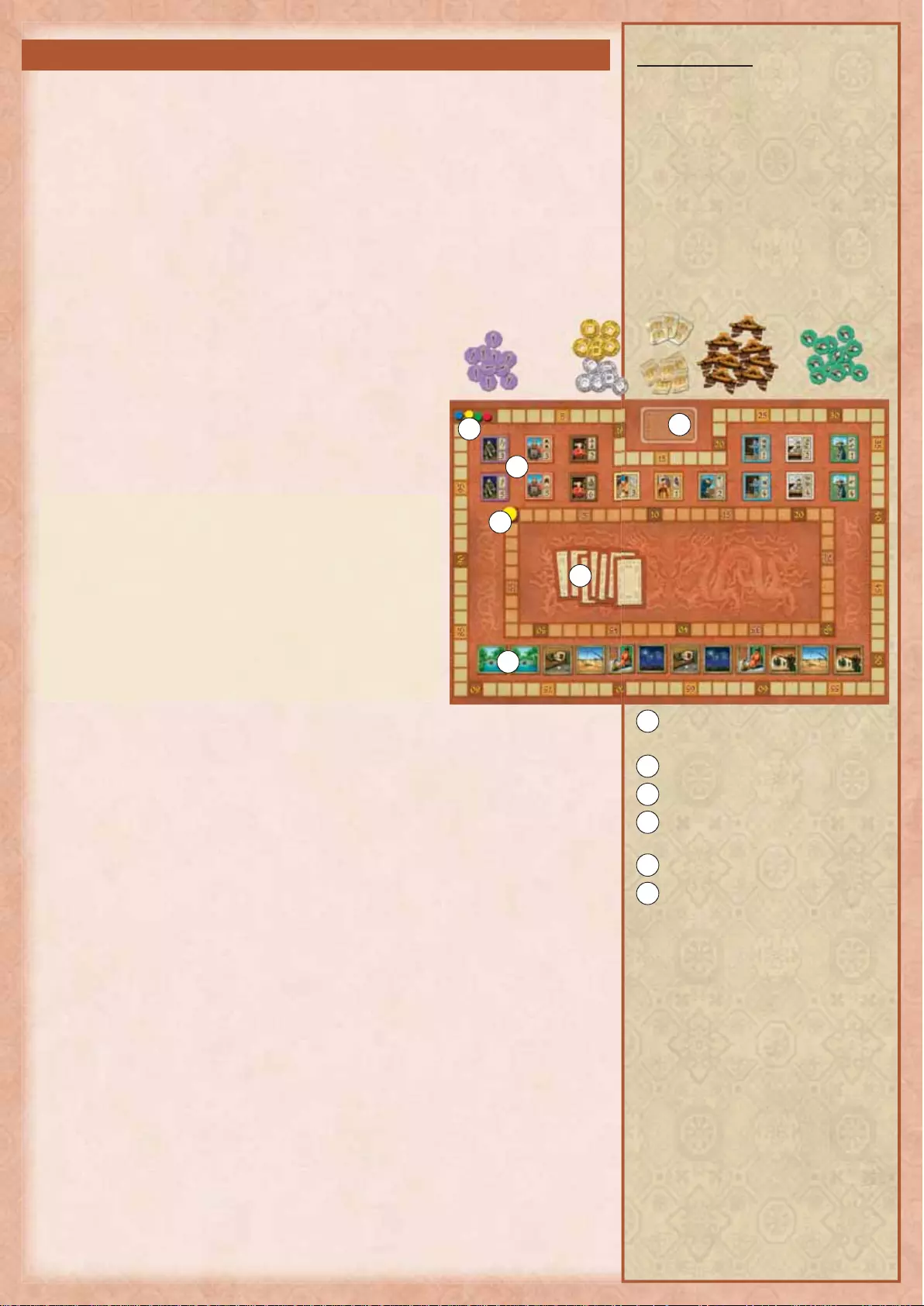
2
PREPARATION
Before your rst game, carefully punch out the tiles from their frames, and place the dragons in
their stands.
Place the game board in the middle of the table. Set up the rest of the pieces
as shown in the diagram.
- e Person Tiles: First sort these tiles by color, then sort them again by
“experience” level/age. Of the 9 types of person tiles, 6 are divided by ex-
perience. For the tiles divided in this way, there will be 6 less experienced
(younger) people (their tiles have fewer symbols and higher values), and 4
more experienced (older) people (with more symbols and a lower value).
Place the older people in the rst row (which con-
tains two sections, each with space for 3 tile types).
en place the matching tiles, with the younger
people, below them in the second row. e crafts-
men (beige), court ladies (orange) and tax collectors
(yellow) only come in the younger version; sort these
into piles by type and place them in the three middle
spaces of the second row.
Note: Only in a 5-player game will you place all 10
person tiles of each type in the display. When playing
with fewer players, return 2 tiles of each type per
missing player to the box (1 younger and 1 older for the
tiles divided into those groups; and 2 younger for the
others, i.e. craftsmen, court ladies and tax collectors).
is means that when playing with 4 players, there will
be 8 tiles of each type in the game; with 3, there will be
6 of each; and with 2, there will be 4 of each.
- e Event Tiles: Locate the 2 peace tiles, and place them face up in the rst
2 spaces of the event row at the bottom of the board (containing 12 light-
colored spaces). Shue the remaining 10 tiles face down and then randomly
draw one at a time, placing them face up from left to right in the other 10
spaces in the event row. With the exception of the 2 peace tiles, there may
never be 2 identical event tiles next to each other, so if you draw 2 of the
same type in a row, slide the second one into the next free space.
- e 7 Action Cards: oroughly shue the 7 action cards and place them
in a face down pile in the middle space on the board.
Each player takes the following pieces, in any color:
- 1 person marker (round), placing it on the 0 space of the person track (the
inner track in the middle of the board);
- 1 scoring marker (8-sided), placing it on the 0 space of the scoring track
(around the outside of the board);
- 1 dragon (in a stand), placing it in the individual player’s play area;
- 11 person cards (of the player’s chosen color), forming the player’s hand.
(e replacement cards are only used to replace lost or damaged cards, and otherwise
remains in the game box.)
PREPARATION
Place the person tiles on the board
(sorted by younger and older), along
with the event tiles (2 peace tiles
rst, then randomly shued), and
the action cards (in a face down
pile)
Each player takes:
· 1 person marker (person track)
· 1 scoring marker (scoring track)
· 1 dragon
· 11 person cards
· 1 game overview
· 4 palace oors (2 2-story palaces)
· 6 yuan
e person tiles (1st row: tiles with more
symbols; 2nd row: tiles with fewer symbols)
e discard pile for person cards
e 7 action cards
e 12 event tiles (2 peace tiles, then
random)
e scoring markers
e person markers on the person track
1
4
2
5
3
6
1
4
2
5
3
6
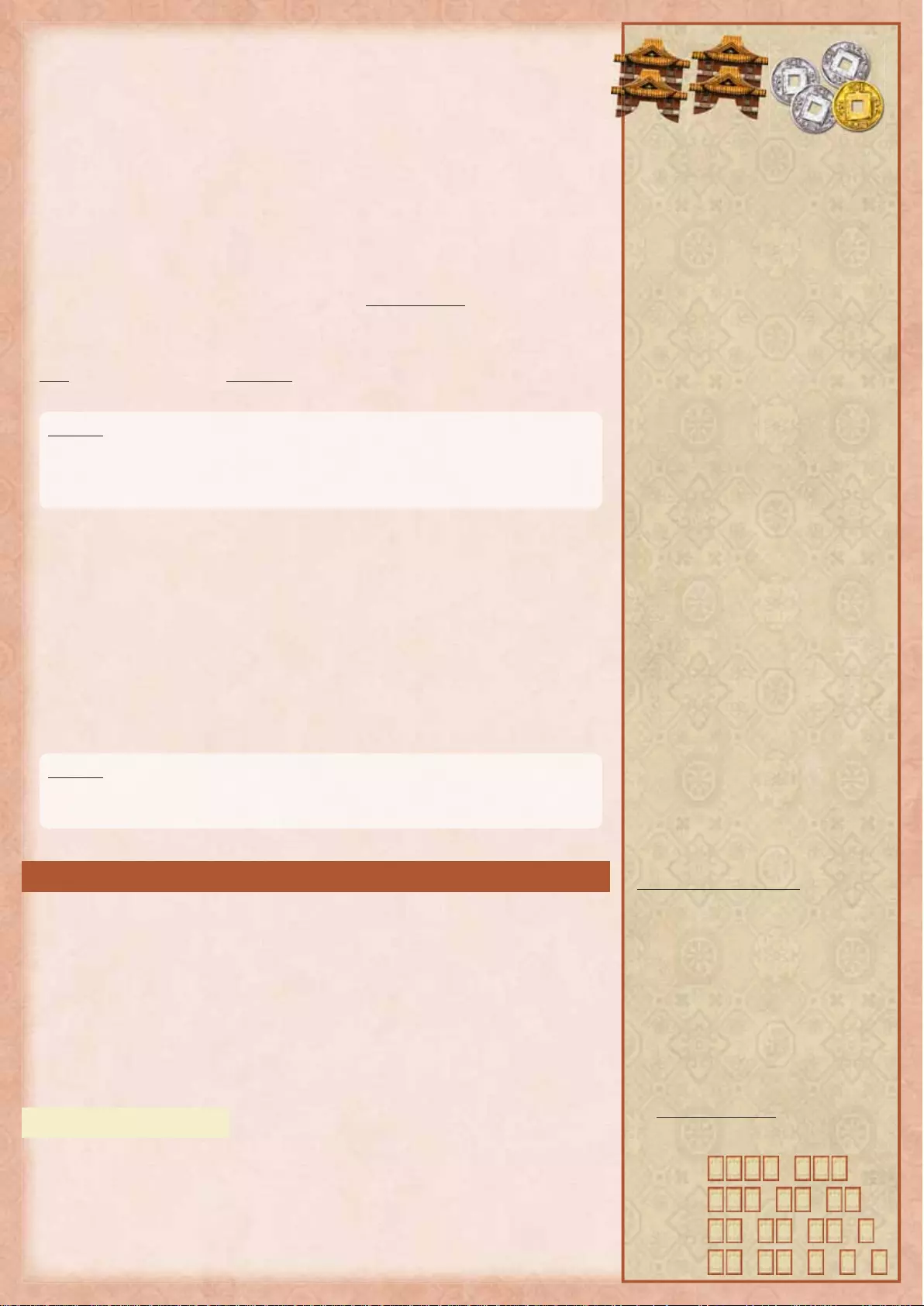
3
Additionally, each player takes 4 palace oors and builds 2 palaces with 2
stories each and takes 6 yuan (3 silver and 1 gold).
(Each player should place the money next to the palaces for all to see. Players may exchange 1 gold
coin with 3 silver coins from the supply at any time during the game.)
Sort the remaining coins, along with all of the other pieces (palace oors, rice
tiles, fireworks tiles, privilege tiles) into a general supply above the board (see
the QSFWJPVT diagram).
Before the game begins
Each player must summon the rst 2 subjects to court. e oldest player
begins by taking 2 dierent person tiles from the second row (i.e. the younger
persons). In clockwise order, all other players choose their rst 2 person tiles,
following the same restrictions.
Note: No player may take the exact same combination of 2 person tiles, that have already
been chosen by another player.
Example: As the start player, Anna takes a tax collector and a scholar. Next, Ben takes
a tax collector and a farmer. When he nishes, Clara takes a scholar and a farmer.
e remaining players may not take a combination of tax collector/scholar, tax collector/
farmer or farmer/scholar ...
Now and throughout the game, players must place each person tile below any
one of their palaces. A palace with 1 GMPPS may only contain 1 person tile; a
palace with 2 GMPPST may contain up to 2 person tiles; and a palace with 3
GMPPST may contain up to 3 person tiles. A palace may never have more than
3 GMPPST.
Every time a player takes a new person tile and places it below a palace, the
player must also immediately move their person marker forward on the person
track the full number of spaces shown on the newly assigned person tile (values
1 to 6). If the marker lands on the same space as that of another player, it is
placed on top of that player’s marker.
Example: In the above example, Anna moves her person marker to space 7. en, Ben
must move his marker to the same place, so he places his on top of Anna’s. Clara goes
next, moving her marker to space 8.
PLAYING THE GAME
The game consists of exactly 12 rounds, SFQSFTFOUJOH the 12 months in the
Year of the Dragon. Each round consists of the following 4 phases, in order:
f 1st Phase: Action
f 2nd Phase: Person
f 3rd Phase: Event
f 4th Phase: Scoring
f1st Phase: Action
Shuffle the 7 action cards face down at the start of this phase. Then place
them, still face down, in the large center space on the board in as many groups
as there are players (e.g., if there are 2 players, they are divided into 2 groups;
if there are 3 players, 3 groups, etc.). e cards should be divided as evenly as
possible. Afterward, turn the cards face up, making sure they are visible to all.
Place the remaining pieces (money,
rice sacks, reworks, privileges,
palace oors) above the board
Before the game begins, all players
take 2 person tiles and place them
in their palaces (only younger, never
2 of the same, no identical combina-
tions between players)
A palace may only contain
1 person per oor
No palace may have more than
3 oors
Players must always move their
person markers forward the
number of spaces corresponding
to the number on their new person
tile
PLAYING THE GAME
Each round consists of 4 phases,
in order:
f 1st Phase: Action
f 2nd Phase: Person
f 3rd Phase: Event
f 4th Phase: Scoring
f 1st Phase: Action
Lay out action cards in 2 to 5 groups:
2 Players:
3 Players:
4 Players:
5 Players:
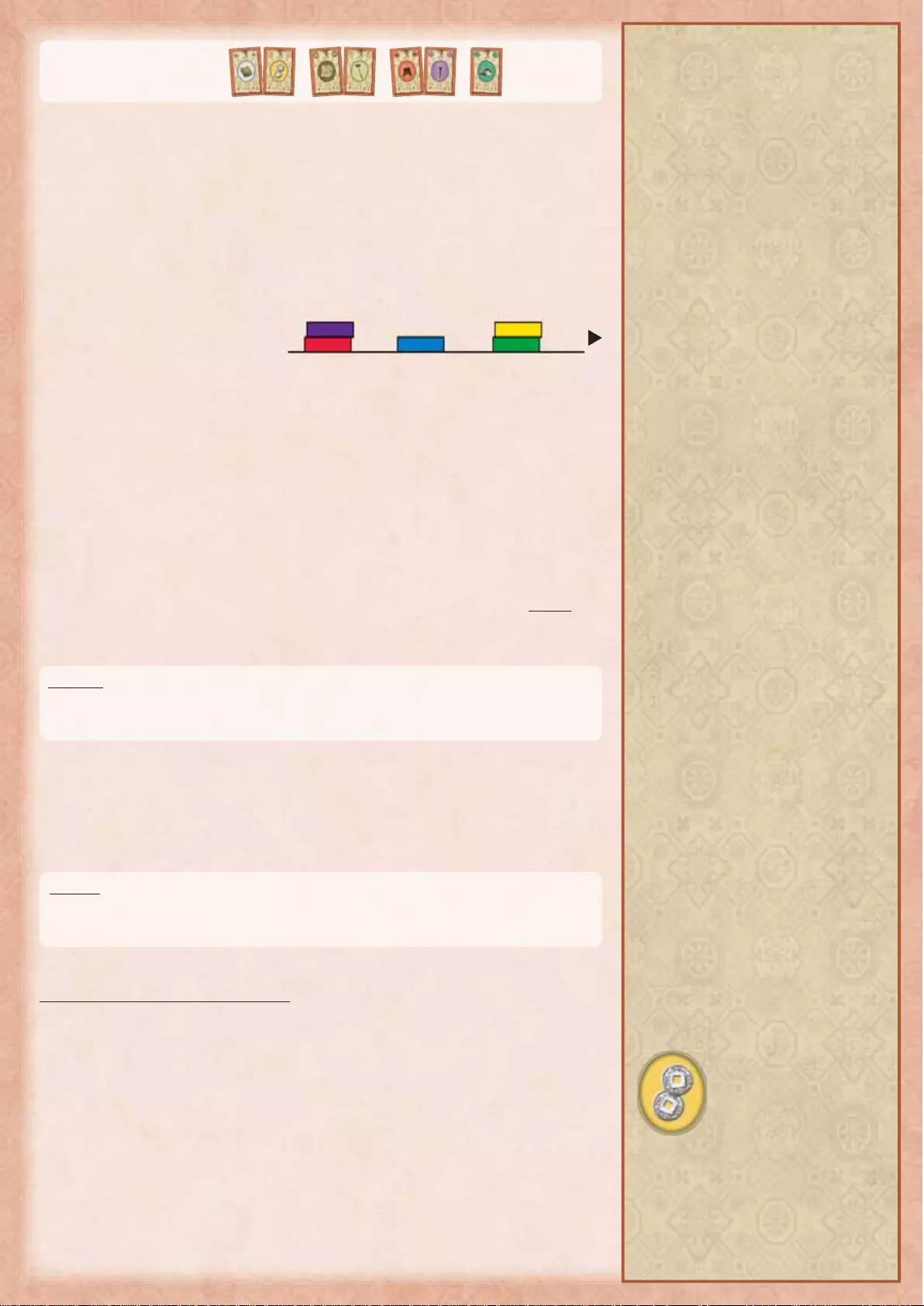
4
Example for a display
in a 4-player game
After the display is complete, the player whose person marker is farthest ahead
on the person track selects 1 group, places their dragon on it, and carries out
exactly 1 of the actions in the chosen group. Next, the player whose marker is
second farthest on the person track does the same, and so on. This means that
player turn order is not determined by the way the players are seated but rather
is governed throughout the game by the players’ positions on the person track.
If multiple person markers share a space, players take turns in top-to-bottom order.
In this example, players take
turns as follows: yellow rst, green
second, blue third, purple fourth,
red fth.
In player order, the other players take turns choosing a group of cards (a
player may select a group that was already chosen by a previous player),
placing their dragons on them and carrying out the action shown on any 1
card in the chosen group (including an action taken by a previous player).
When all players (in order of the person track) have taken an action, players
take back their dragons and place the action cards in a face down pile in the
middle space on the board.
Note: A player who chooses a group of cards already chosen by at least 1 other
player that round (meaning, there is at least 1 dragon on it) must pay 3 yuan
(by returning the appropriate coins to the general supply). If the player
cannot pay 3 yuan, the player cannot place their dragon POUIBUHSPVQ.
Example: Dora would like to take an action from a group of cards that already has 2
dragons on it. She pays 3 yuan to the supply and performs an action of her choice from
that group.
Instead of placing a dragon on 1 of the groups of cards and carrying out
a corresponding action, a player may skip the rst phase completely and
instead take up to 3 yuan from the supply. In other words, the player doesn’t
necessarily take 3 yuan, but only as many coins as needed in order to have a
total of 3 yuan!
Example: Emil does not want to take an action, but prefers to stock up on money.
He has 1 yuan already, so he takes 2 more from the general supply. This concludes
Phase 1 for Emil.
e Individual Actions, in detail:
Taxes:
Players choosing this action take 1 yuan from the supply for each of the 2
coins shown on the card as well as 1 additional yuan for each coin shown on
any tax collectors (yellow) in their palaces.
Besides the person tiles,the gameTIPVMEOPU run out of pieces. If any of thF other pieces
(such as money, privileges, palace floors, rice, fireworks, etc.) should run out, temporarily
substituteUIFNXJUI any suitable markers.
e player whose marker is farthest
ahead on the person track takes the
rst action
All other players carry out 1 action
each in order of their person
markers on the person track
If a player selects a group of cards
previously chosen by another
player, then that player must pay
3 yuan
Instead of placing a dragon, a
player can replenish up to 3 yuan
e Actions
Taxes:
Take 1 yuan from the
supply for each coin
symbol (on the card and
on each of the player’s tax
collectors)
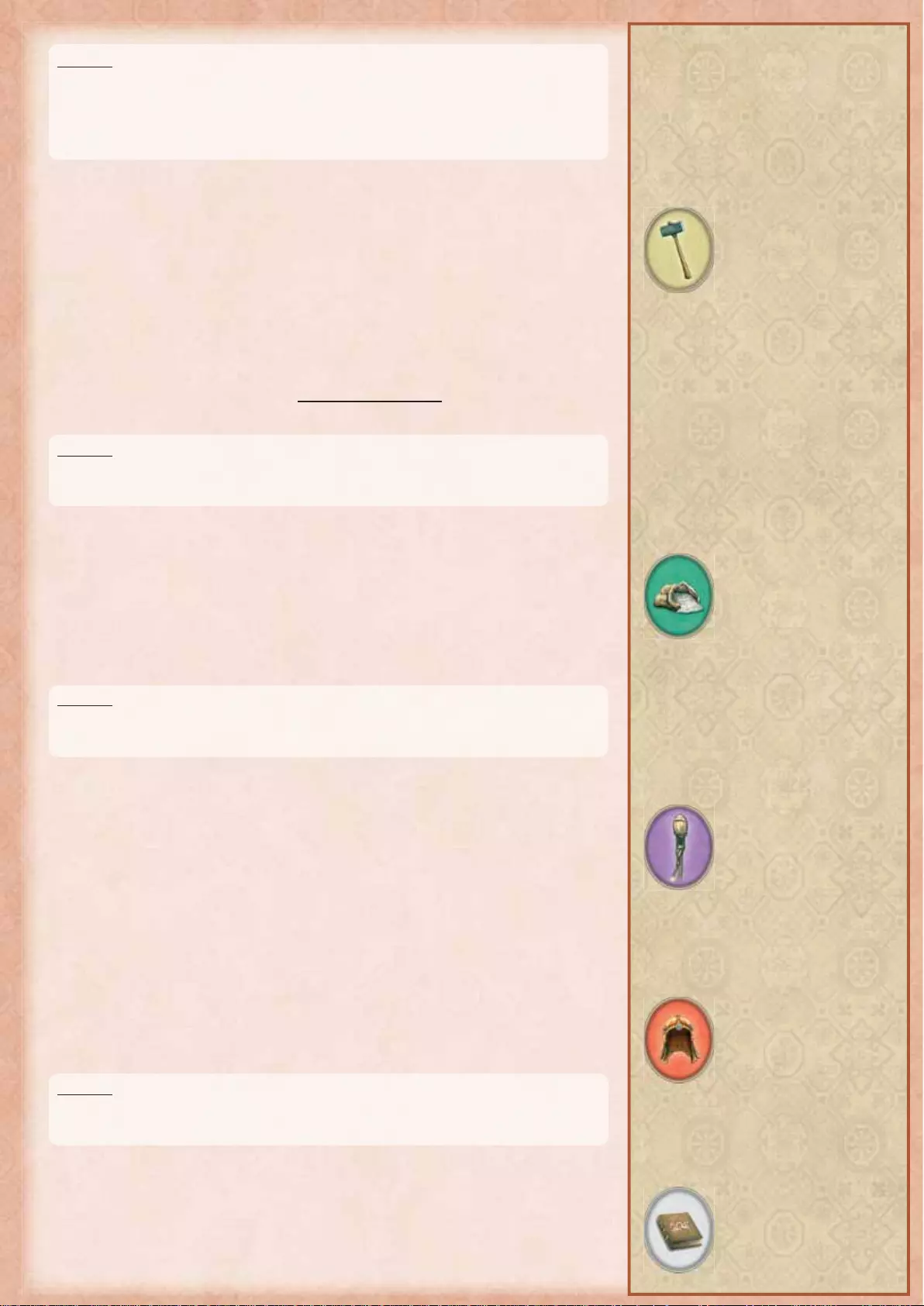
5
Example: Clara chooses the action “Taxes.” She has no tax collectors in her palaces.
Accordingly, she takes 2 yuan from the general supply. Next, Anna, who has 2 tax
collectors, chooses the same action. She pays 3 yuan to the general supply (because
Clara already has her dragon on this group), and then takes 8 back from the supply
(2 + 3 + 3).
Build:
Players choosing this action take 1 palace oor from the general supply for
the hammer shown on the action card as well as 1 additional palace oor for
each hammer shown on any craftsmen (beige) in their palaces.
e player may build these new palace oors either by adding oors to
existing palaces (bearing in mind that no palace can have more than 3 oors),
or building new palaces from 1 to 3 stories high. ere is no limit to the
number of palaces a player may own.
Note: A player may only build the newly acquired oors. Already placed palace
oors may not be rearranged.
Example: Emil chooses the action “Build.” He has 2 craftsmen in his palaces, so he
takes 3 palace oors from the supply. He uses 2 to transform an existing 1-story palace
into a 3-story palace, and with the third, he starts a new 1-story palace.
Harvest:
Players choosing this action take 1 rice tile from the general supply for the
rice sack shown on the action card as well as 1 additional rice tile for each
rice sack shown on any farmers (green) in their palaces, and place these rice
tiles in plain view beside the palace.
e use of these tiles will be explained later, in the section for the “Drought” event.
Example: Anna takes the action “Harvest.” She has 1 younger farmer (1 rice sack)
and 1 older farmer (2 rice sacks) in her palaces. She takes a total of 4 rice tiles from
the supply (1 + 1 + 2).
Fireworks Display:
Players choosing this action take 1 reworks tile from the supply for the
rocket shown on the card as well as 1 additional reworks tile for each
rocket shown on any pyrotechnists (purple) in their palaces, and place these
reworks tiles in plain view beside the palace.
e use of these tiles will be explained later, in the section for the “Dragon Festival”
event.
Military Parade:
Players choosing this action move their person marker 1 space forward on
the person track for the helmet shown on the action card as well
as 1 space for each helmet shown on any warriors (red) in their palaces.
Example: Ben takes the action “Military Parade.” He has 2 older warriors
(2 helmets apiece) in his palaces, so he moves his person marker forward 5 spaces
(1 + 2 + 2).
Research:
Players choosing this action move their scoring marker 1 space forward on
the scoring track for the book shown on the action card as well as 1 space for
each additional book shown on the scholars (white) in their palaces.
Build:
Take 1 palace oor from
the supply for each
hammer (on the card and
on each of the player’s
craftsmen), then build
the new oors; no palace
higher than 3 oors
Harvest:
Take 1 rice tile from the
supply for each rice sack
(on the card and on the
player’s farmers)
Fireworks Display:
Take 1 reworks tile
from the supply for each
rocket (on the card and on
the player’s pyrotechnists)
Military Parade:
Move 1 space on the
person track for each
helmet (on the card and
on the player’s warriors)
Research:
Move 1 space on the
scoring track for each
book (on the card and on
the player’s scholars)
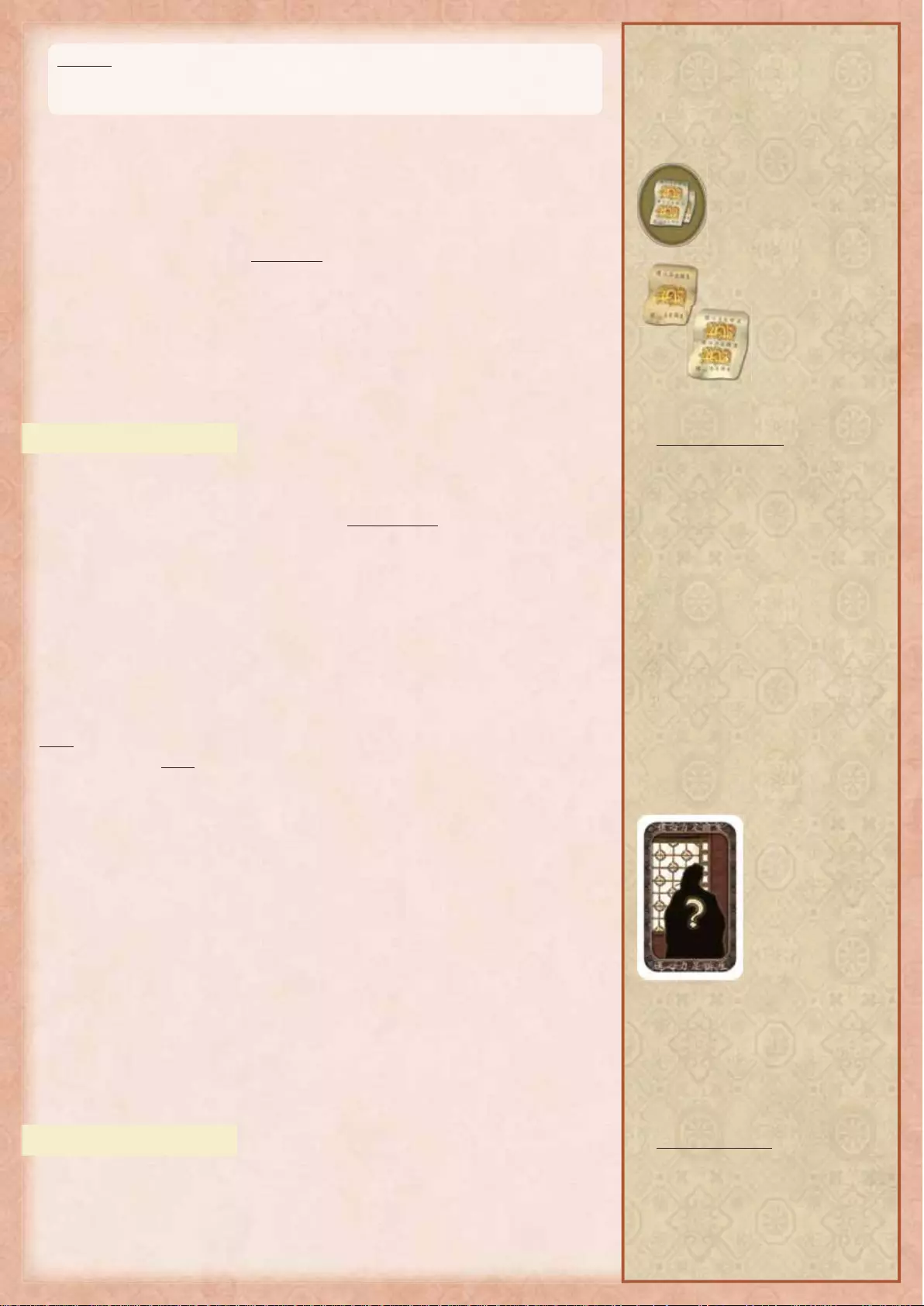
6
Example: Dora takes the action “Research.” She has 1 younger scholar (2 books) and
1 older scholar (3 books) in her palaces, so she moves her scoring marker forward 6
spaces (1 + 2 + 3).
Privilege:
Players choosing this action pay either 2 yuan to obtain a small privilege or
7 yuan for a large privilege (paying the money to the general supply), and
then place their privilege tile next to their palaces.
A player may only purchase 1 privilege per action, even if the player has the
money for more. A player may accumulate any number of privileges. At the
end of each round, players score 1 victory point for each dragon shown on
their privilege tiles.
* Note: DragonsBSFFRVJWBMFOUUP victory points. Therefore, dragons appear on privileges,
scholars’ texts, and the fans of the court ladies.
f 2nd Phase: Person
After all players have taken an action or replenished their supply of yuan to 3,
each player, in the order shown on the person track (which may have changed
through the action “Military Parade”), plays 1 person card from their hand onto
the common discard pile on the board. e player then takes the matching
person tile from the board and places it below any of their palaces. If all
palaces are full, the player may replace 1 of their existing person tiles. e
displaced courtier is then “released from royal service”. All persons released in
this manner are removed from the game (which means they are not placed in
their pile on the board again!).
Afterward, the player moves the person marker forward on the person track
the number of spaces equal to the value on the new person tile.
Notes:
Person markers are never moved backward when a person gets released (due to replacement
or an event).
Acquiring new person tiles does not entitle a player to immediately take new rice tiles,
reworks tiles, money, victory points, etc. Rather, the person tiles generate resources only
through corresponding actions chosen in later action phases. A player who plays a card
with a question mark may choose any person tile from the display.
If players have room in their palaces, they must summon new people to their court. If all
palaces are full, and a player does not want to replace an existing courtier, the player can
instead release the new person by removing the tile from the game.
However, in this case, the player may not move their marker forward on the person track.
If a player plays a card showing a courtier whose tile is no longer available on the board,
then that player gets nothing (i.e. does not get a substitute person).
In the 12th round, players skip the second phase because they will not have any person
cards in their hands at that point.
f 3rd Phase: Event
After each player plays a person card, a monthly event takes place. In the rst
2 rounds, the event is “Peace”. In subsequent rounds, each month’s event is
dictated by the next event tile in the event row, going from left to right. After
the event is complete, turn the corresponding event tile face down.
Privilege:
Pay 2, or 7, yuan to the
supply and take a small,
or large, privilege tile
from the supply
= small (2 Yuan)
= large (7 Yuan)
f 2nd Phase: Person
In the order shown on the person
track, each player:
· plays 1 person card from their
hand,
· takes the matching person tile,
· places it in 1 palace,
· moves their person marker for-
ward
If all of a player’s palaces are full,
the player can replace an existing
person tile in any palace
= any person tile
f 3rd Phase: Event
ere are 6 dierent event types:
peace, imperial tribute, drought,
Mongol invasion, dragon festival,
and contagion
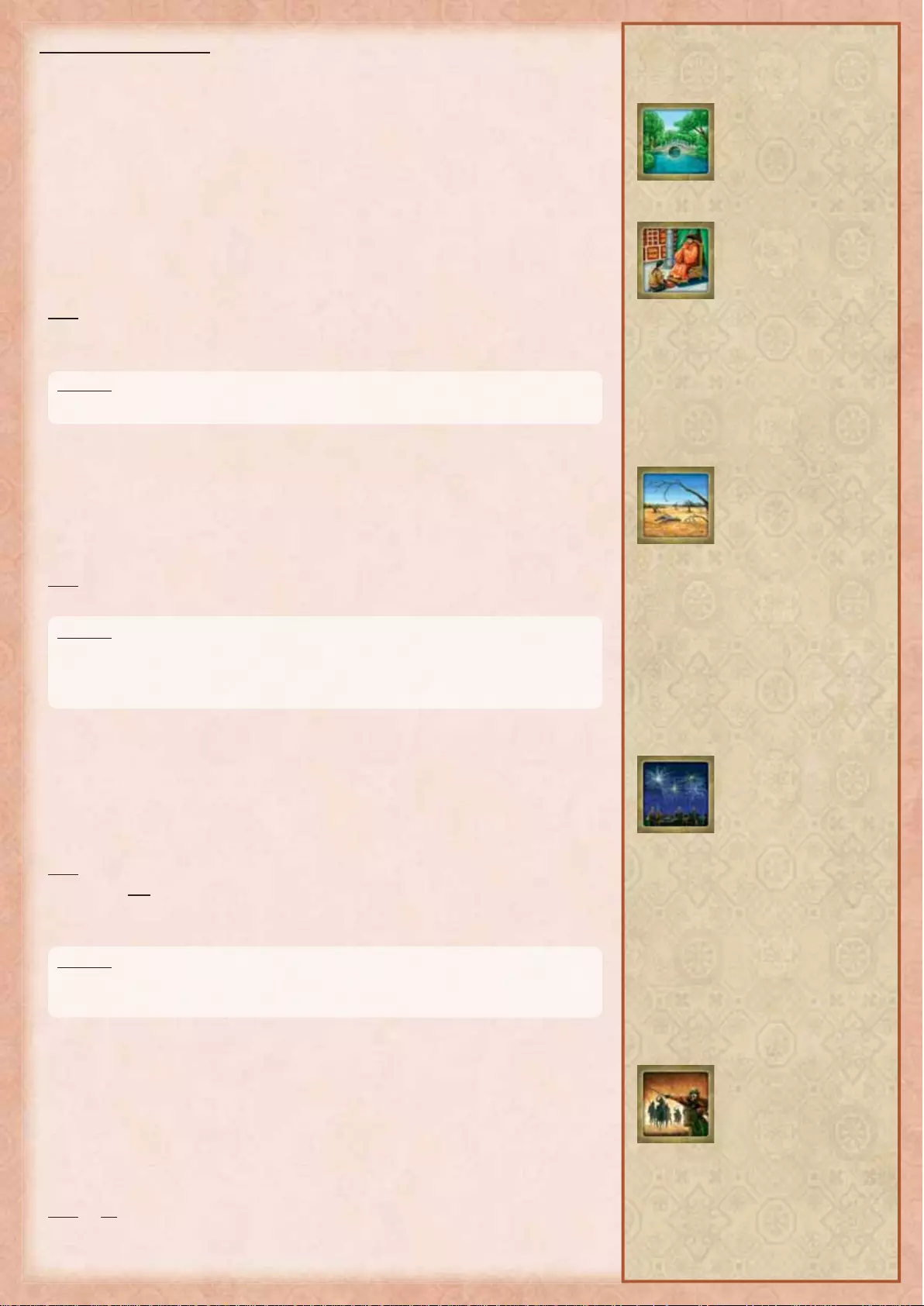
7
e Individual Events:
Peace:
Nothing happens.
Imperial Tribute:
Each player must pay 4 yuan in tribute to the emperor (placing the coins
into the general supply). If a player does not have enough money, the player
releases 1 person from any 1 palace for each missing yuan.
Note: Players may not voluntarily release a person from their court in an eort to hold
onto their money. Also, the coins pictured on the players’ tax collectors do not count for
anything when paying tribute.
Example: Clara only has 2 yuan. She must pay these in tribute, and for the missing
2 yuan, she must release 2 people from her palaces.
Drought:
Each player must return 1 rice tile to the supply for each of their palaces that
has at least 1 person. If a player does not have enough rice tiles, the player
must release 1 person from each palace that cannot be supplied (in which
case the aected player chooses which palace(s) will go unsupplied).
Note: Players may not voluntarily release a person in an eort to hold onto rice tiles.
Moreover, the rice pictured on the farmers does not count for anything during a drought.
Example: Anna has 3 inhabited palaces and 1 empty palace along with 4 rice tiles.
Anna returns 3 rice tiles to the supply and thereby withstands the drought. Ben also
has 3 inhabited palaces, but he has no rice tiles. Ben must release 1 person from each
of his 3 palaces.
Dragon Festival:
e player or players with the most reworks tiles get 6 victory points, and
the players with the second most get 3 victory points. Afterward, the scoring
players must return half of their reworks tiles to the supply (rounding up
when necessary).
Note: If multiple players tie for rst, they all get the full 6 points, and the players in
second place still get their points. Players who have no reworks tiles cannot score any
points. e rockets pictured on the pyrotechnists do not count for anything during dragon
festival scoring.
Example: Clara and Emil each have 3 reworks tiles. Anna has 2, and Ben 1. Clara
and Emil each get 6 points (and turn in 2 reworks tiles), whereas Anna gets 3 points
(and turns in 1 tile). Ben gets nothing (and turns in nothing).
Mongol Invasion:
Players move their scoring marker forward on the scoring track as many
spaces as the total number of helmets on all warriors in their palaces.
Additionally, the player or players with the fewest helmets must each
release 1 person from any 1 of their palaces.
(is can even be a warrior who was just counted.)
Note: If all players have an equal number of helmets (including, for example, none),
then each must release 1 person from service.
Peace:
Nothing happens
Imperial Tribute:
Each player pays 4
yuan
For each yuan a player
is short, release 1 person
Drought:
Each player must turn
in 1 rice tile for each
inhabited palace
Release 1 person from
each unsupplied palace
Dragon Festival:
Players get 6, or 3,
victory points for the
most, or the second
most, reworks tiles
Scoring players then
return half of their tiles
to the supply
Mongol Invasion:
Each player scores
points equal to
the number of their
helmets
e player(s) with the
fewest must each release
a single person
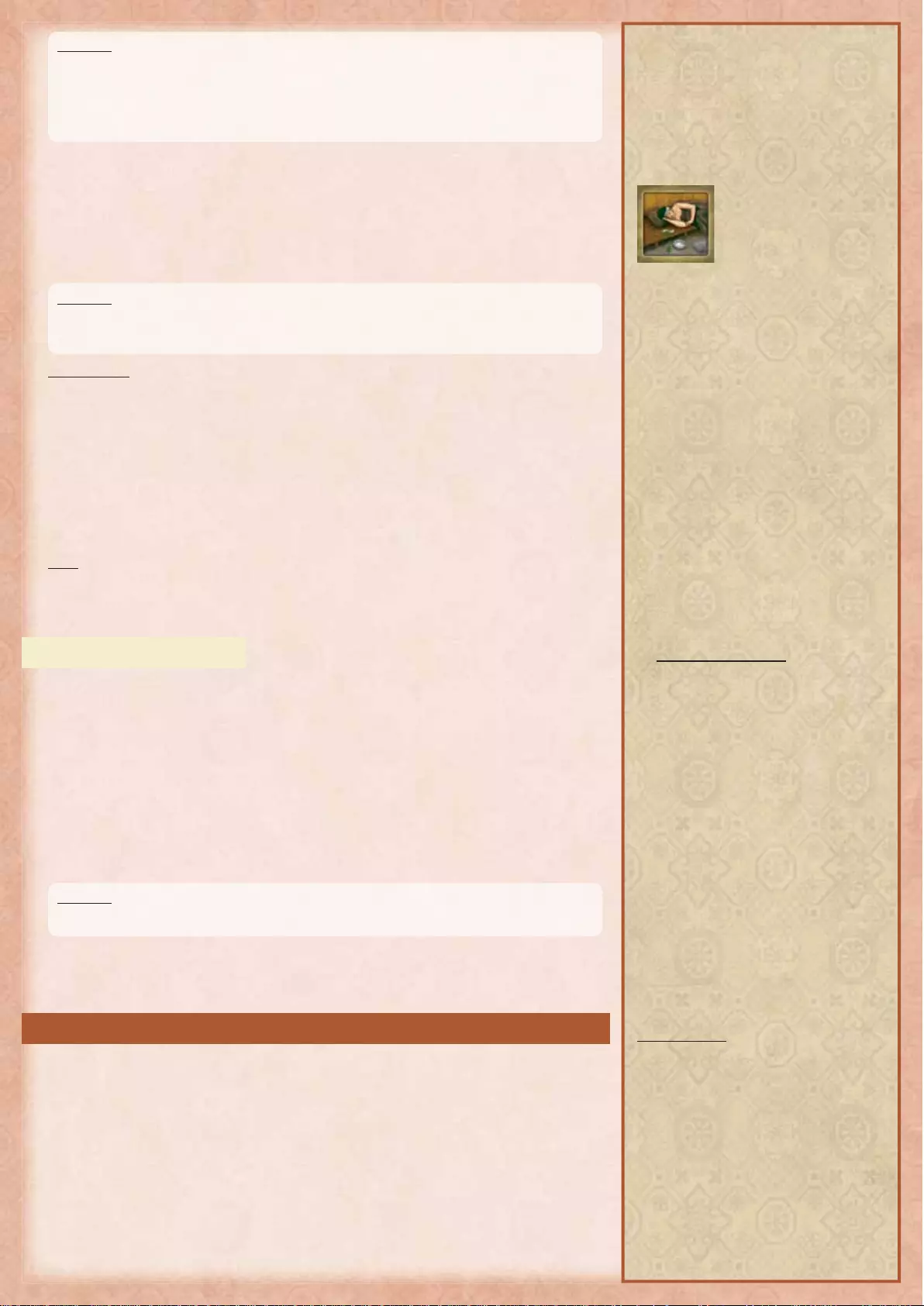
8
Example: Anna and Ben each have warriors in their palaces showing a total of 3
helmets, whereas Clara has 2, and Dora and Emil have 1 helmet each. Anna and
Ben move 3 spaces forward on the scoring track, Clara moves 2, and Dora and Emil
move 1. Afterward, Dora and Emil must each release 1 person from among their
palaces.
Contagion:
Each player must release 3 people of their choosing from their palaces.
Players can protect their provinces from the spread of disease through
the services of their healers (blue). For each mortar pictured on a player’s
healers, the player releases one person fewer.
Example: Clara has 2 younger healers (each with 1 mortar) in her palaces.
Consequently, she loses 1 person instead of 3. (is may include a healer who just
protected her.)
General Rule: If multiple players are required to release courtiers from service at
once, the dismissals occur in the player order shown on the person track.
Decay:
After an event occurs, players must check to see if they have any uninhabited
palaces. If so, each uninhabited palace must be reduced by 1 oor (by return-
ing lost palace oors to the supply). Note that this can lead to the complete
disappearance of an unpopulated, one-story palace.
Note: Because of this rule, there is no point in a player choosing the “Build” action to
create a one-story palace without assigning a person to it in the very next person phase!
f 4th Phase: Scoring
After the current event is nished, and any uninhabited palaces have fallen
into decay, players move their scoring markers forward on the scoring track,
earning 1 point apiece for:
- each palace (regardless of whether or not they are inhabited or how many
oors they have),
- each dragon on the fans of the court ladies (orange), and
- each dragon on the privileges.
Example: Anna has 3 palaces containing, among other courtiers, 2 court ladies and
1 large privilege: she moves her scoring marker forward 7 spaces (3 + 2 + 2).
e round is nished, and a new one begins ...
GAME END
e game ends after the scoring phase is complete at the end of the 12th
round. Each player earns additional victory points in the nal scoring as
follows:
- for each person: each person tile in the player’s palaces is worth 2 victory
points;
- for each monk (brown): to calculate the points produced by each monk,
multiply the number of Buddhas on the monk by the number of oors in
Contagion:
Each player must
release 3 persons
1 fewer per mortar
Decay:
After each event, all uninhabited
palaces lose 1 oor
f 4th Phase: Scoring
Each player scores victory points
for:
· palaces (1 point each)
· court ladies (1 point each)
· privileges (1 point per dragon)
GAME END
e game ends after the scoring
phase of the 12th round
Each player gets additional victory
points for
· person tiles (2 points each)
· monks (Buddhas x oors)
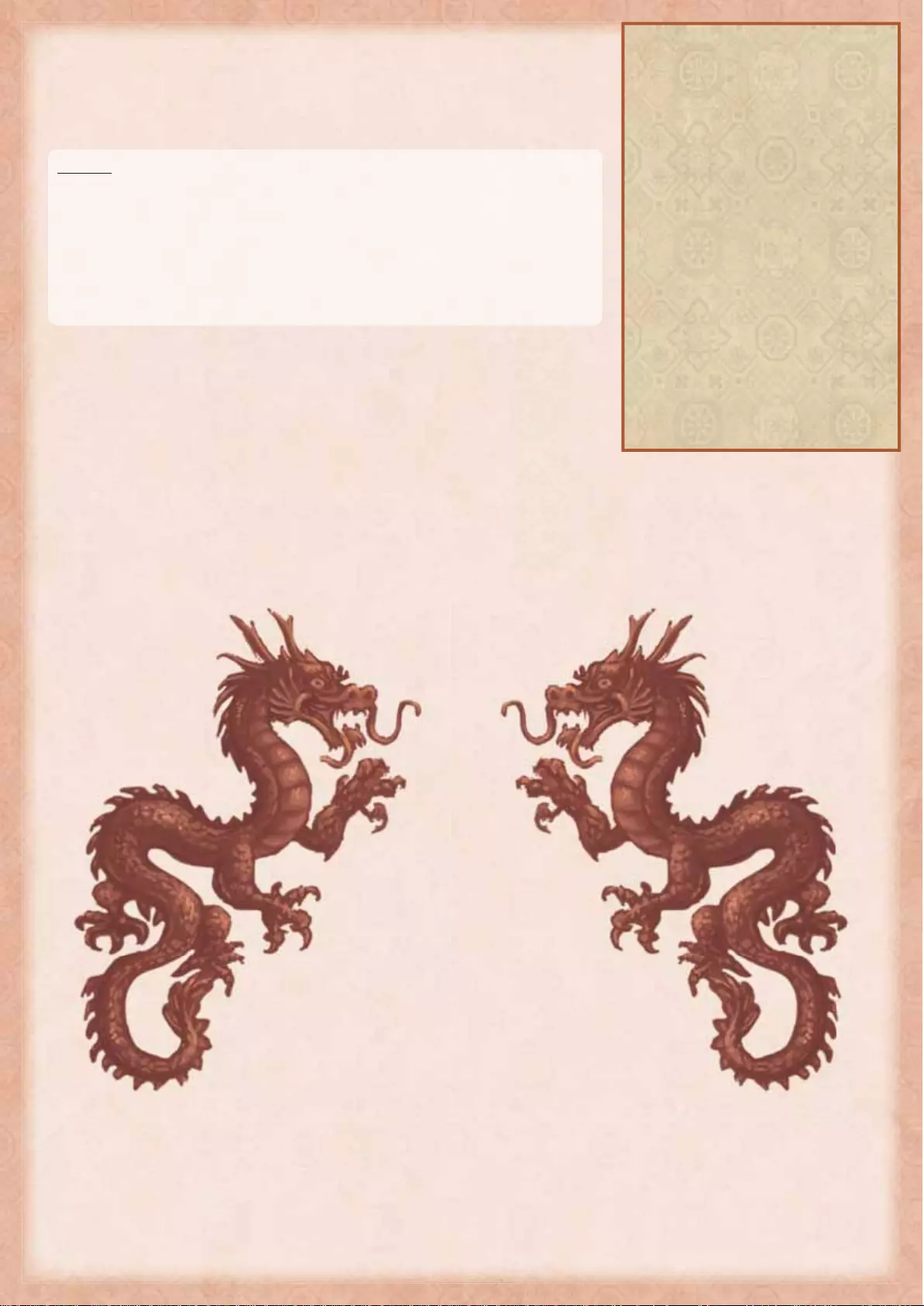
9
the palace the monk inhabits;
- for the player’s remaining money: rst, each player sells back to the supply
all rice and reworks tiles for 2 yuan each. en, each player earns 1 victory
point for every 3 yuan.
Example: At the end of the game, Ben has 7 courtiers in his palaces (including 1
younger monk in a 2-story palace and 1 older monk in a 3-story palace), 1 rice tile,
2 reworks tiles and 4 yuan. Ben scores a total of 25 additional victory points:
- 14 points for the 7 people;
- 8 points for the 2 monks: 2 (1 x 2) + 6 (2 x 3) = 8;
- 3 points for his 10 yuan (10 divided by 3) (with 10 yuan representing the 4 he
already had plus the 6 he gained from the sale of his 1 rice and 2 reworks tiles).
The winner and most successful ruler is the player whose marker is farthest
on the scoring track at UIFFOEPGUIFHBNF. In the case of a tie, the winner is
the player (among those who are tied) whose marker is farthest ahead on the
person track.
· coins (3 yuan = 1 point)
e player with the most victory
points wins
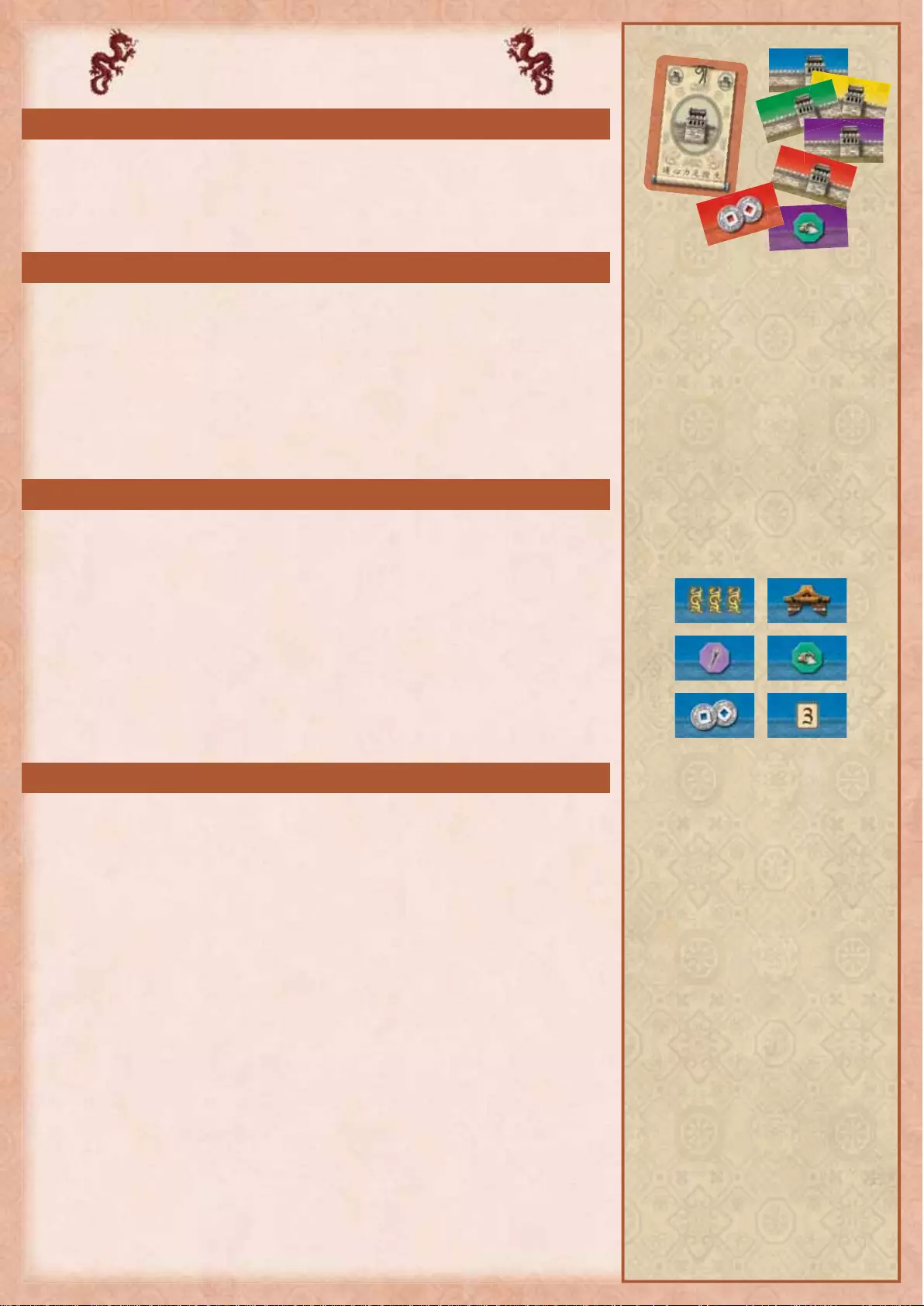
10
Players take 6 wall tiles of one color,
placed face down
Shue the “building the wall” action
card with all other action cards
e “building the wall” action card
can be selected like all others
Whoever builds a wall tile receives
its privilege
WALL SCORING
e wall is scored after the Mongol
invasion event:
- If the wall reaches the Mongol
invasion event tile, players with
tiles in the Great wall earn 1
victory point per tile
- If the wall does not reach the
Mongol invasion tile, players who
have built the fewest wall tiles
must release 1 person
After 12 rounds, score the wall again
EXPANSION I:
“THE GREAT WALL OF CHINA”
CONTENTS
1 action card (“building the wall”), 30 wall tiles (6 per player)
All rules of the original game remain unchanged, except for the following:
PREPARATION
Players each take the 6 wall tiles of their color and place them face down
(= dierent symbols) in their play area.
Shue the “building the wall” action card with the other actions cards and
then place all 8 in groups as in the rules for the basic game.
e “building the wall” card can be selected just like all other action cards.
PLAYING THE GAME
When a player selects the “building the wall” action card, the player chooses
one of their unused wall tiles and receives the privilege indicated on it: either a
rice tile, reworks tile, one palace section, 2 yuan, 3 spaces on the person track, or
3 victory points.
Next, the player places the used wall tile, wall side up, underneath the rst
event tile (from the left) without a wall tile under it. As wall tiles are used,
players place them under the event tiles from left to right, thereby building
the Great Wall of China (maximum of 12 wall tiles).
WALL SCORING
In the two rounds aected by the Mongol invasion event, after the eects of
the Mongol invasion are completed, the wall is scored.
ere are two possibilities:
- If the wall has been built to at least the current Mongol invasion event tile,
each player with one or more wall tiles in the Great Wall earns one victory
point for each tile in the player’s wall.
- If the wall has not been built to at least the current Mongol invasion event
tile, the player or players who have built the fewest wall tiles (including
none) must each release 1 person from any 1 of their palaces.
At the end of the 12th round, there is another wall scoring. In this case, if the
wall is built with 12 tiles, players score 1 point for each wall tile they placed.
If the wall has less than 12 tiles, the player or players with the fewest tiles in
the wall must each release 1 person from any 1 of their palaces.
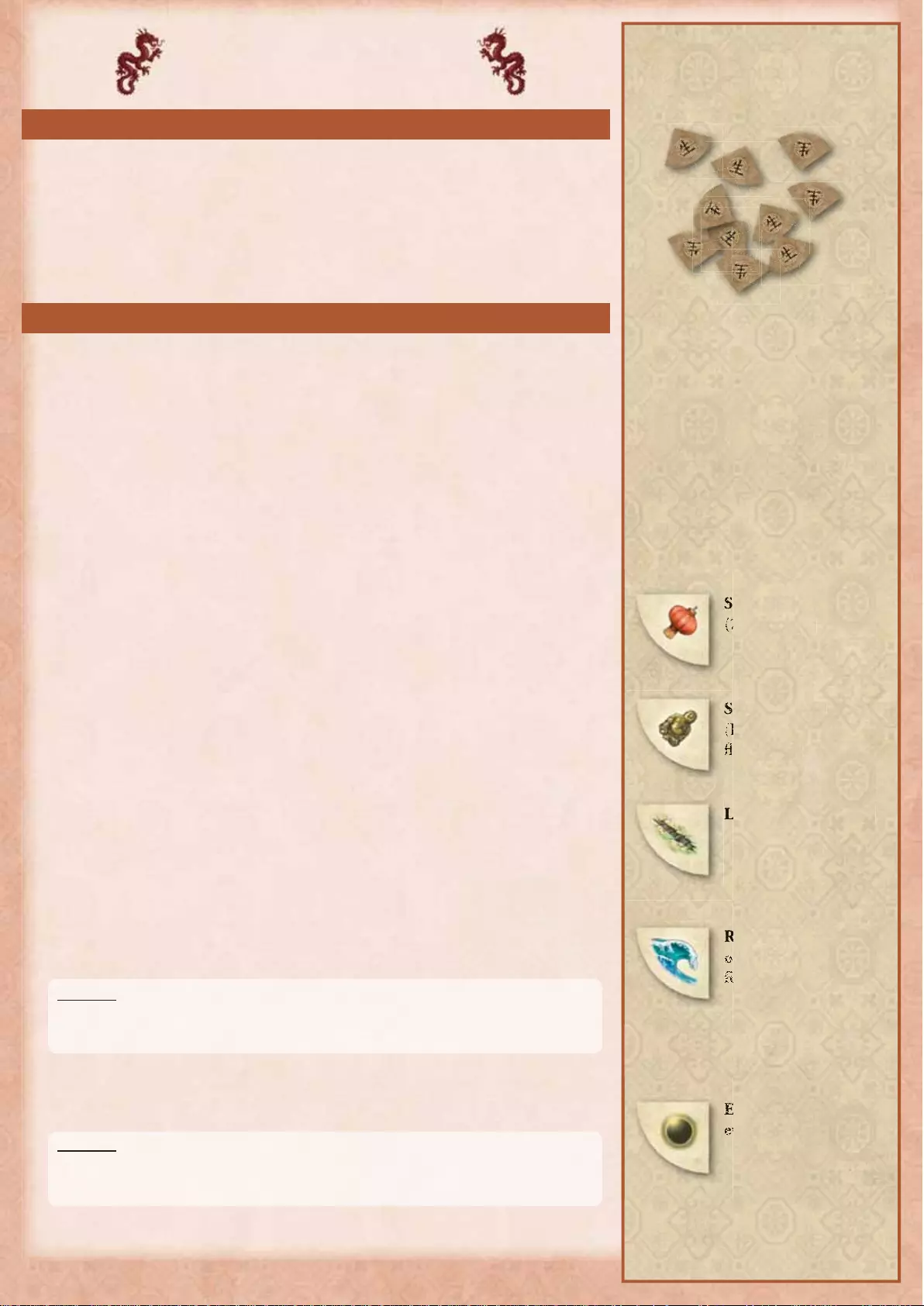
11
Shue the 10 corners, choose one
and place it on the 7th event tile
Score people
(2 VP/person)
Score Buddhas
(Buddha x number of
oors = VP)
Lose 2 palace sections
Return half the total
of: yuan + rice tiles +
reworks tiles
Execute the 7th round
event a second time
EXPANSION II:
“THE SUPER EVENTS”
CONTENTS
10 small super events
All rules of the original game remain unchanged, except for the following.
Players can play with either one or both expansions at the same time if they
choose.
PREPARATION
Shue the ten “corners” face down. en, choose one at random and place
it on the seventh event tile (on the upper right corner). Place the 9 unchosen
tiles back in the box as they will not be used in the game.
e eect of the chosen Super Event is handled after the normal event and
before the scoring of the seventh round.
(Note: e group can decide amongst themselves which super event they want for the
game. is can occur either before or after laying the normal events out.)
Lanternfest:
Players score the people in their palaces, as at game end: each player earns
2 victory points for each person.
Buddha:
Players score monks just as they would at game end: Buddhas x number of
oors = victory points.
Earthquake:
Beginning with the startJOH player, each player loses any two palace
sections (back to the supply).
is may require players to release people.
Flood:
Beginning with the startJOH player, each player adds their yuan, rice tiles,
and fireworks tiles, and returns half the total (rounded down).
Example: Anna has 3 yuan, 2 rice tiles, and 2 reworks tiles for a total of 7.
Of these, she must discard 3, e.g. 2 yuan and 1 reworks tile, or 1 yuan and 2
rice tiles, etc.
Solar eclipse:
Execute the event of the seventh round a second time.
Example: e event is a dragon festival. All players who earn victory points
discard half of their reworks tiles. en, a dragon festival is executed again
(with now possibly dierent results).
SS
S
SS
S
S
S
S
S
S
S
S
S
S
S
S
S
S
S
S
S
S
S
S
(2(2
(2
(
(2
(2
(2
2
(2
(2
(
(2
(2
(
(2
(2
(2
(
(2
(2
(2
2
(
SS
S
SS
S
S
S
S
S
S
S
(B
(B(B
(B
(B
(B
(B
(
(
(B
(
(B
B
(B
(
B
LLL
L
L
L
L
L
L
L
L
L
L
L
L
L
L
L
L
L
L
L
L
L
R
RR
R
R
R
R
R
R
R
R
R
R
R
R
R
R
R
R
R
o
oooo
o
o
o
o
o
o
o
o
o
o
o
o
o
o
o
E
E
E
EE
E
E
E
E
E
E
E
E
E
ev
ev
ev
ev
e
e
e
e
v
e
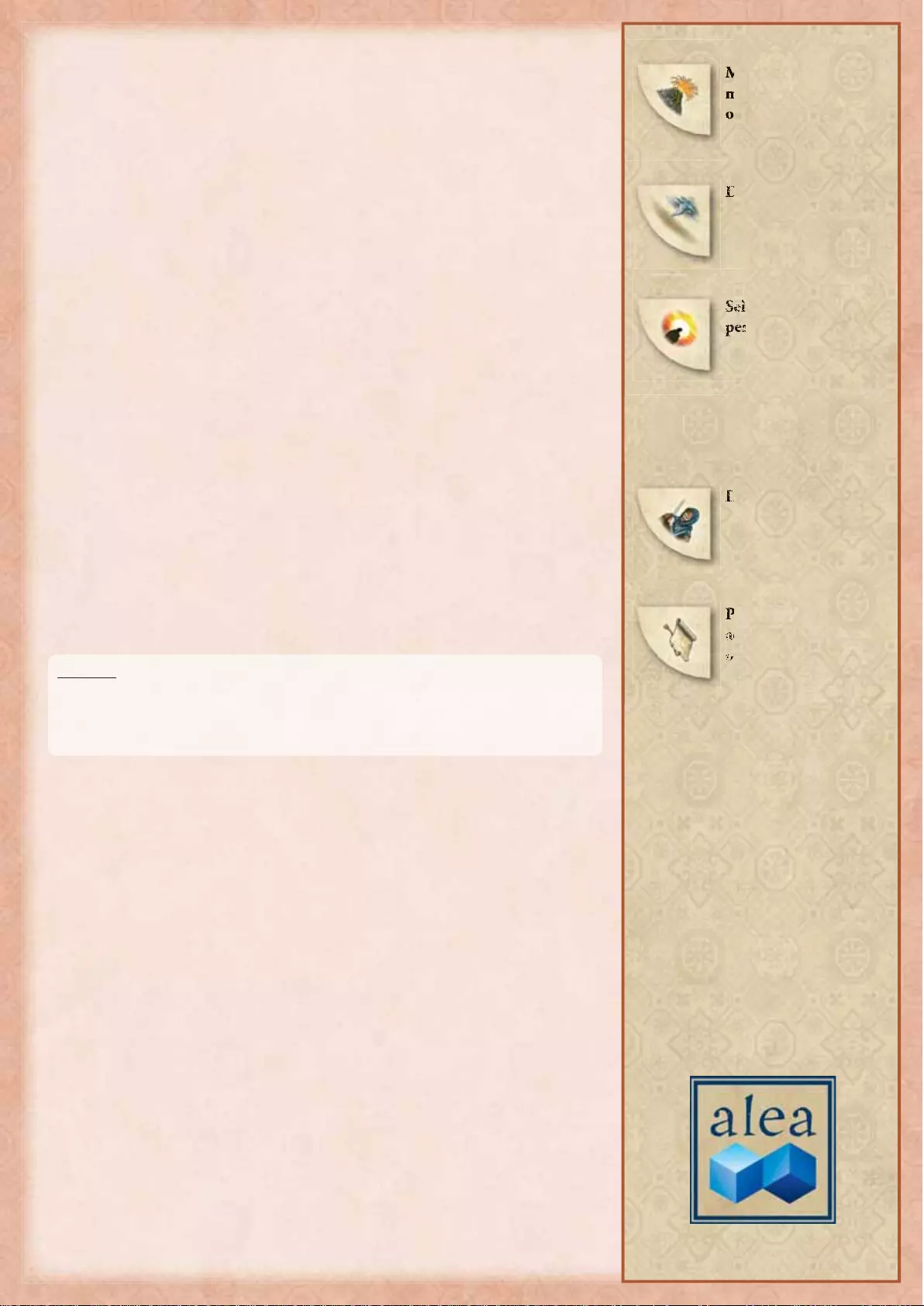
12
Move all person
markers to space 0
on person track
Discard 2 person cards
Select one young
person
Discard all privileges
Players takes the
advantage of one type
of person in their realm
Volcanic eruption:
All players move their person markers to space 0 on the person track, with-
out changing the actual order (i.e. the marker of the leading player is on top
and the marker of the last player is on the bottom).
Tornado:
Beginning with the startJOH player, FBDI player must discard 2 of their
person cards. This means that the players have only one card each for the
months 8 and 9 - and skip the person phase in the months 10, 11, and
12.
Sunrise:
Beginning with the startJOH player, each player selects a young person to place
(note: XJUIPVUOFFEJOH the appropriate person card!) and plays it according
to the 2nd phase rules. Then, the player moves their person marker forward
along the person track the appropriate number of spaces.
Note: During the sunrise, no person who was already selected by one player may
be selected by another player.
Assassination attempt:
All players must discard all their privileges - without compensation! - back
into the supply. us, the privileges are not scored in the scoring phase that
follows.
Charter:
Beginning with the startJOH player, each player selects one type of person
in their realm and receives the advantages that type of person offers.
Example: Anna chooses her farmers and takes a tile from the supply for each
rice bag shown. Alfonzo chooses his monks and takes victory points equal to
Buddhas x number of oors.Valerie chooses her scholars and takes one victory
point for each shown book.
Do you have comments or questions about this game? Contact us:
Ravensburger USA, Inc. | 1 Puzzle Lane | Newton, NH 03858
E-Mail: info@aleaspiele.de | www.aleaspiele.de
© 2007 Stefan Feld
© 2007/2017 Ravensburger Spieleverlag
234 701
M
M
M
M
M
M
M
M
M
M
M
M
M
M
M
M
M
M
M
M
M
M
M
M
M
M
M
M
M
M
M
M
M
M
M
M
M
M
M
M
M
M
m
mm
m
m
m
m
m
m
m
m
m
m
m
m
m
m
m
m
m
m
m
m
m
m
m
m
m
m
m
m
m
o
o
o
o
o
oo
o
o
o
o
o
o
o
o
o
o
o
o
o
o
o
o
o
o
o
o
o
o
o
D
DDD
D
DD
D
D
D
D
D
ee
e
e
e
e
e
e
e
e
e
e
e
l
l
l
l
l
l
l
l
l
l
pe
pepe
pe
pe
pe
pe
e
pe
e
p
e
e
e
r
r
r
r
r
r
r
SSSS
S
S
S
S
S
S
S
S
S
S
S
S
p
p
p
p
p
p
p
p
p
p
p
p
p
p
p
p
p
p
p
p
p
p
p
p
p
p
p
p
p
p
p
p
p
p
p
p
p
p
p
p
p
p
p
p
p
p
p
p
p
p
p
p
D
D
D
D
D
D
D
D
D
D
D
D
D
D
PP
P
PP
P
P
P
P
P
P
P
P
P
P
P
P
P
P
P
P
P
P
P
a
ad
ad
adad
ad
ad
a
ad
a
a
a
a
a
o
o
o
o
o
o
o
o
o
o
o
o
o
o
o